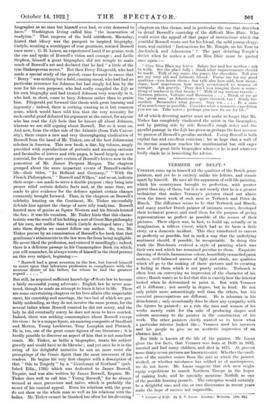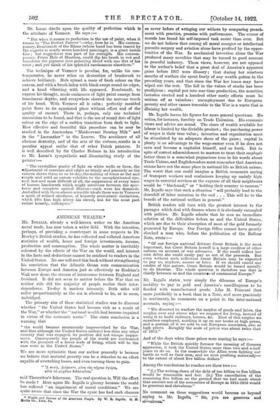VERMEER OF DELFT.*
VERMEER sums up in himself all the qualities of the Dutch genre painters, and yet he is entirely unlike his fellows, and stands apart by himself. He uses all the apparatus of still-life painting, which his countrymen brought to perfection, with greater power than any of them, but it is not merely that he is a greater technician that makes Vermeer's pictures stand out above even the finest work of such men as Terborch and Peter de Hooch. The difference seems to be that Terborch and Hooch, and many another Dutch painter of intimate scenes, developed their technical powers and used them for the purpose of giving representations as perfect as possible of the scenes of their pictures. Their object was, in fact, to build up, actually or in imagination, a tableau vivant, which had as its basis a little story, or a domestic incident. This they transferred to canvas as perfectly as possible, but in such a way that the underlying sentiment should, if possible, be recognizable. In doing this work the Dutchmen evolved a style of painting which was their own and which has remained peculiar to them. Exquisite drawing of details, harmonious colour, beautifully enamelled paint surface, well-balanced masses of light and shade, are qualities which all go to the making of these pictures and to creating a feeling in them which is not purely artistic. Terborch is often bent on conveying an impression of the character of his sitter; Hooch wants us to feel that this is exactly how the interior looked when he determined to paint it. But with Vermeer all is different ; not merely in degree, but in kind. He not only paints more astonishingly well than the others, but his essential preoccupations are different. He is inhuman in his detachment ; only occasionally does he show any sympathy with the figures he painted ; as a rule the men and women of his works merely exist for tho sake of producing shapes and colours necessary to the painter in the construction of his work. The other painters chiefly wanted us to know what a particular interior looked like ; Vermeer used his interiors and his people to give us an aesthetic impression of an abstract kind.
But little is known of the life of the painter. Mr. Lucas gives the few facts, that Vermeer was born at Delft in 1632,
married and had many children, and died in 1675. At present some thirty-seven pictures are known to exist. Whether the small- ness of the number comes from the rate at which the painter, worked, or whether mischance has robbed us of masterpieces, we do not know. Mr. Lucas suggests that rich men might equip expeditions to search Northern Europe in the hopes of making finds, and he specially mentions Norfolk as one of the possible hunting grounds. The enterprise would certainly be a delightful one, and one or two discoveries in recent years make the hope of success not impossible.
• Vermeer of Delft. By E. V. Lucas. London : Methuen. LW& &LI
Mr. Lucas dwells upon the quality of perfection which is the attribute of Vermeer. He says :—
" But when it comes to perfection in the use of paint, when it comes to The Perfect Painter '—why, here he is. His contem- porary, Rembrandt of the Rhine (whose hand has been traced by the experts in nearly seven hundred paintings), is a giant beside him ; but ruggedness was part of his strength. His contem- porary, Franz Hals of Haarlem, could dip his brush in red and transform the pigment into pulsating blood with one flirt of his wrist ; and yet think of his splendid carelessness elsewhere."
The technique of Vermeer is peculiar, for, unlike his con- temporaries, he never relies on dexterities of brushwork to achieve brilliancy. Hals spread a mass of fresh colour on the
canvas, and with a brush laden with black swept round its edges, and a band vibrating with life appeared. Rembrandt, to express his thought, made eminences of light paint emerge from translucent depths, and everywhere showed the nervous touch of his. hand. With Vermeer all is calm ; perfectly moulded
paint flows to its appointed place without effort and of the quality of enamel. There is, perhaps, only one technical mannerism to be found, and that is the use of round dots of light colour on the edge of a sudden transition from dark to light.
How effective and beautiful this procedure can be may be studied in the Amsterdam "Maidservant Pouring Milk" and in the " Lacemaker " in the Louvre. The avoidance of all obvious dexterity, and of the arts of the virtuoso, results in a peculiar appeal unlike that of other Dutch painters. It is well described by Sir Charles Holmes in his introduction to Mr. Lucas's sympathetic and illuminating study of the painter:— "The crystalline purity of light on white walls or linen, the adjustment of contours and edges as trimly and precisely as the camera shows them to us to-day, the making of tones as flat and simple and solid as nature exhibits to the unsophisticated eye, and, last and most difficult of all, the suppression of every trace of human handiwork which might intervene between the spec- tator and complete optical illusion—such were his demands. And allied with these almost scientific ideals there was in Vermeer a spirit of refined aloofness, of leisurely aristocratic distinction, which lifts him high above his clever, but for the most part rather homely, colleagues."



































 Previous page
Previous page